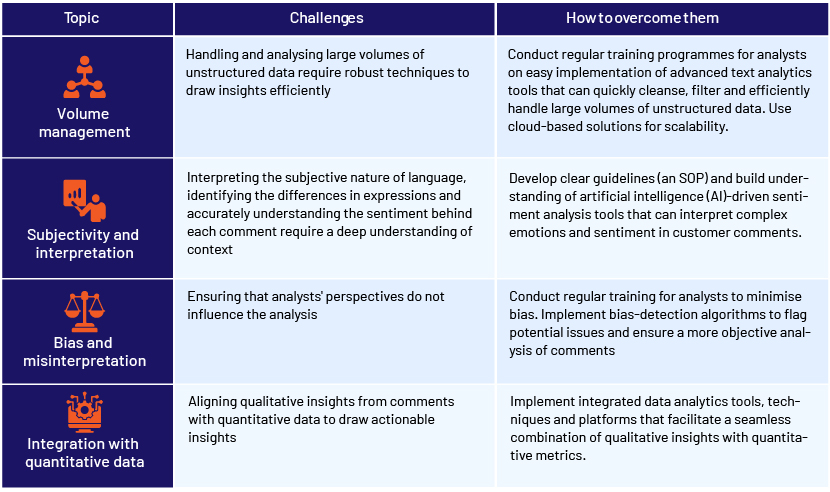Published on March 12, 2024 by Udit Mohan
In the dynamic landscape of modern business, customer experience (CX) has emerged as a major factor of success. CX encompasses a customer’s interactions and experience with an organisation/brand across touchpoints throughout their journey – from initial product enquiry to post-sale services. In today’s world, where customers switch to the next best player in the industry at the slightest discontent, it has become vital for organisations to understand customers’ changing needs and preferences, explore innovative ways to maintain customer loyalty and stay at the forefront of competition.
As a result, organisations are investing heavily in collecting customer feedback through surveys, public forums, social media and other consumer platforms. Customer feedback is a combination of qualitative and quantitative data that provides a substantial amount of information about a customer’s experience with a product or service and hence a treasure trove from which actionable insights on customer pain points, sentiment and preferences can be drawn.
Although most companies depend on key scores such as the Net Promoter Score (NPS), Overall Satisfaction Score (OSAT), Client Loyalty Index (CLI) and Client Health Index (CHI) to understand the level of customer satisfaction, these metrics mostly help in acquiring quantified knowledge. They are not enough for identifying the key issues customers may be facing or specific customer pain points the company needs to address more strategically.
In such a scenario, customer verbatim – word-for-word excerpts of what a customer has to say about their experience – is the most reliable source of data, as it provides an unfiltered picture of the customer’s requirements, opinions and feelings. In an era of information and data overload, verbatim analysis plays a vital role in harnessing the wealth of information embedded in customer feedback.
What is verbatim analysis?
Verbatim analysis is a strategic process that aims to extract meaningful information from the unstructured and raw remarks customers provide by adding qualitative depth to quantitative data. It is an important part of the CX framework, as it helps guide businesses to make precise improvements by dissecting customer comments word by word, primarily to break the monopoly of quantitative metrics and gain a deep understanding of a customer’s sentiments and experiences.
Combining quantitative metrics with qualitative insights ensures a comprehensive understanding of customer feedback, enabling businesses to navigate the complexities of the new-age business landscape with precision and agility.
Key benefits of verbatim analysis
1. In-depth customer insights:
Verbatim analysis goes beyond quantitative metrics, providing a qualitative understanding of customer sentiment, pain points, requirements and preferences. It complements quantitative data by offering an in-depth understanding of a customer’s experience throughout their journey.
2. Customer understanding:
By examining raw, unfiltered comments, businesses gain insight on customer perspectives, helping them tailor products and services.
3. Identification of pain points:
Verbatim analysis helps pinpoint specific issues or pain points raised by customers. This information is invaluable for addressing weaknesses in products or services and enhancing overall customer satisfaction.
4. Identification of trends:
Analysing customer comments and remarks helps identify emerging trends and patterns in customer behaviour, so businesses can proactively respond to evolving customer expectations.
5. Opportunities to personalise:
Understanding the language and expressions used by customers allows for more personalised interactions. Tailoring communication and offerings based on verbatim insights enhances the overall customer experience.
How to overcome the challenges of verbatim analysis
Analysing and interpreting a vast number of verbatim comments can be a complex task, requiring advanced tools, understanding and methodologies to identify actionable insights. Gathering such a large amount of data presents a unique set of difficulties – from ensuring a representative sample to managing the high volume of responses.

Overcoming the challenges of verbatim analysis requires a strategic combination of human expertise and cutting-edge technology. AI and other emerging technology not only solve problems such as volume control and bias, but also improve the depth and speed of analysis. However, human knowledge and expertise are required to understand and train the AI-based platform to navigate the complexities of customer feedback and transform insights into actionable strategies for continuous improvement and sustained CX success in a dynamic marketplace.
How Acuity Knowledge Partners can help
We provide customer experience research and insight support to stakeholders in the B2B and B2C space and help companies comprehend the new-age needs of customers. Equipped with a 360-degree view, we understand how customer data can be captured and analysed and how the results can be leveraged to deliver a seamless customer experience and achieve better business outcomes. We help Fortune 500 technology corporations, mid-tier companies and startups leverage customer feedback on people, products and processes to remain flexible and better serve their customers.
Sources:
-
https://www.mckinsey.com/featured-insights/mckinsey-explainers/what-is-cx
-
https://skeepers.io/en/blog/verbatim-analysis-transform-customer-comments-kpis/
-
https://community.goodays.co/en/blog/collecting-customer-verbatim-accounts-the-smart-way
Tags:
What's your view?
About the Author
With over 6.5 years of experience in consulting, strategy, and research, Udit has gained valuable expertise in the finance, technology, and government sectors. He has worked on a variety of projects including survey analysis and insights, data analysis, market analysis, competitive intelligence, industry studies, benchmarking studies, business valuation, and more. Before joining Acuity, he has worked for Compute Value and Resurgent India.
Like the way we think?
Next time we post something new, we'll send it to your inbox







